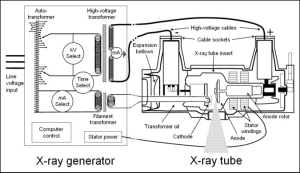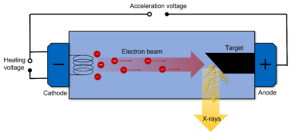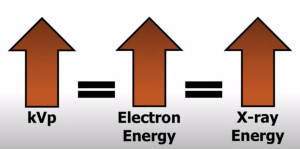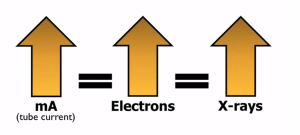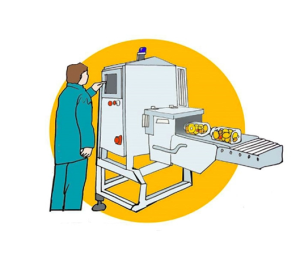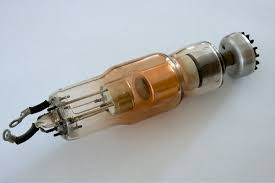Introduction to X-Ray Sources
X-rays are a form of high-energy electromagnetic radiation, and X-ray sources are devices or natural phenomena capable of producing X-rays. Depending on the method of X-ray production, X-ray sources can be classified into natural X-ray sources and artificial X-ray sources.
Natural X-ray Sources VS Artificial X-ray Sources
Natural X-ray sources are radioactive elements or their isotopes that naturally exist in the environment and do not require human-made processes. For example, uranium-238, potassium-40, and radium-226 are common natural radioactive isotopes that emit X-rays during their decay processes.
Artificial X-ray sources, on the other hand, are devices that produce X-rays through technological means, usually by accelerating electrons or exciting certain materials. The X-ray tube is the most common artificial X-ray source, where high-voltage accelerated electrons strike the anode metal target, generating X-rays.
Components of X-Ray Sources
An X-ray generator typically consists of an X-ray tube, high-voltage power supply, filament power supply, high-voltage oil tank, heat exchanger, and control system.
X-ray Tube
The X-ray tube is the core component, consisting of a cathode and an anode in a vacuum. The cathode emits electrons, which are accelerated by the high-voltage electric field and strike the anode target to generate X-rays.
High-Voltage Power Supply
The high-voltage power supply provides thousands to hundreds of thousands of volts (kV) to accelerate electrons from the cathode to the anode. The higher the voltage, the stronger the penetration power of the X-rays. Generally, higher voltage generates more powerful X-rays.
Filament Power Supply
The filament power supply provides low-voltage current to the filament in the X-ray tube’s cathode, heating the filament and releasing electrons. The size of the current directly affects the quantity of emitted electrons, and increasing the tube current can improve image clarity.
High-Voltage Oil Tank
The high-voltage oil tank provides insulation for the high-voltage circuit to prevent electrical breakdown, ensuring the safety and stability of the equipment’s operation. The oil medium has excellent thermal conductivity, which helps cool the heat generated during operation, protecting internal components from overheating and significantly increasing the equipment’s lifespan and reliability.
Heat Exchanger
The heat exchanger is an auxiliary cooling system that uses fans or circulating coolant to dissipate heat generated by the X-ray tube and high-voltage power supply, ensuring normal operation of the equipment.
Control System
The control system regulates the operational status and output parameters of the entire X-ray generator, adjusting the high voltage (kV), filament current (mA), and exposure time, among other settings. It also provides monitoring and protection functions to ensure the system operates stably and safely.
Types of X-Ray Sources
X-ray sources can be classified into two types: closed-tube and open-tube.
Closed-Tube X-Ray Sources
Closed-tube X-ray sources are sealed X-ray tubes where the cathode, anode, and focusing cap are integrated into a sealed vacuum tube. The vacuum inside the tube prevents air interference, allowing the generation of higher energy X-rays, with better stability and efficiency.
Open-Tube X-Ray Sources
Open-tube X-ray sources are designed with an open structure and are not in a vacuum environment, making it easier to replace consumables such as the cathode filament. This type of structure is simpler and more cost-effective, and it is suitable for low-energy X-ray imaging.
Key Parameters of X-Ray Sources
The following are key parameters that affect the performance of X-ray sources:
Focal Spot Size
The focal spot size refers to the area where the electron beam strikes the target, and it directly affects the image resolution and clarity. Smaller focal spot sizes provide higher resolution.
Voltage
Voltage is the potential difference applied to the electrons (kV), which determines the energy and penetration power of the X-rays. Higher voltage can enhance the penetration capability of the X-rays, making it suitable for thicker or denser materials.
Current
Current refers to the quantity of the electron flow (mA), determining the intensity of the X-rays. Higher current increases the X-ray output, improving image clarity and quality.
Power
Power is the total energy output, usually expressed in watts (W), and is a function of voltage and current. The higher the power, the greater the X-ray output capacity.
Other Key Parameters
- Target Material: The target material affects the efficiency and energy spectrum of the X-rays. Common target materials include tungsten and molybdenum, which efficiently produce high-energy X-rays.
- Cooling Method: Cooling is crucial to prevent overheating of the X-ray tube. Common cooling methods include air cooling and liquid cooling.
- Radiation Angle: The radiation angle determines the angle at which X-rays are emitted from the source, influencing the beam collimation.
- Window Material/Thickness: The window material (usually beryllium or glass) allows X-rays to pass through while blocking unnecessary radiation. The thickness of the window material also affects the X-ray transmission.
The Role of X-Ray Sources in Modern Technology
The development and advancement of X-ray sources have greatly accelerated the progress of modern technology, particularly in fields such as medicine, industry, security, scientific research, and food inspection. These technologies have not only changed the way people live and work but have also brought about innovation and efficiency improvements across multiple industries. With continuous technological advancements, X-ray sources will continue to drive innovation and create more application opportunities, particularly in improving diagnostic accuracy, industrial inspection efficiency, and food safety testing.


